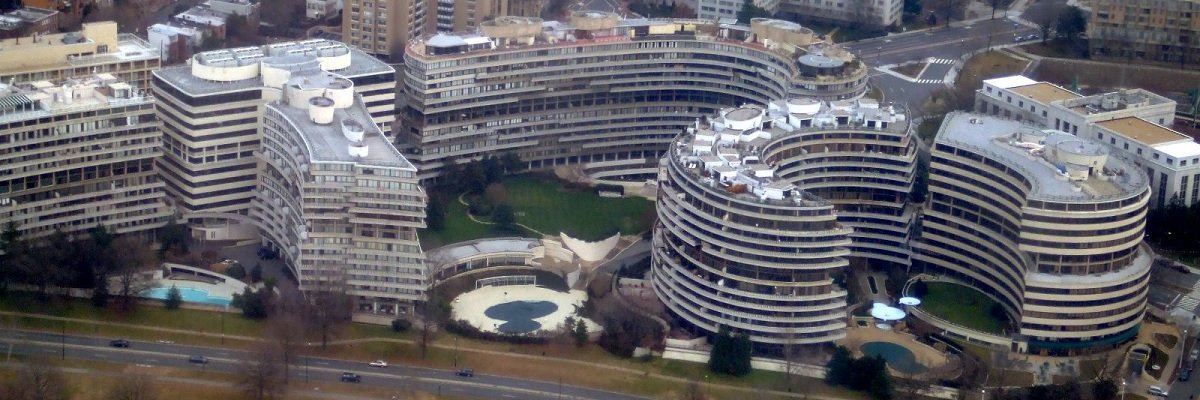Evidence compiled from Federal Bureau of Investigation files, Bob Woodward and Carl Bernstein’s notes, statements from Deep Throat, along with Congressional testimony and the files of Senate investigators, all implicate journalist Jack Anderson as having helped set up Watergate - or at least having foreknowledge of it and benefiting from it.
According to an FBI memo, Danny Casolaro contacted the FBI with copies of two letters that had been written to the Democratic National Committee warning them of Watergate break-in type activity. The Bureau essentially shrugged this off, noting that Casolaro’s theory was that the Watergate was a setup to embarrass the White House, and that Casolaro suspected Watergate burglar and former Central Intelligence Agency officer E. Howard Hunt.
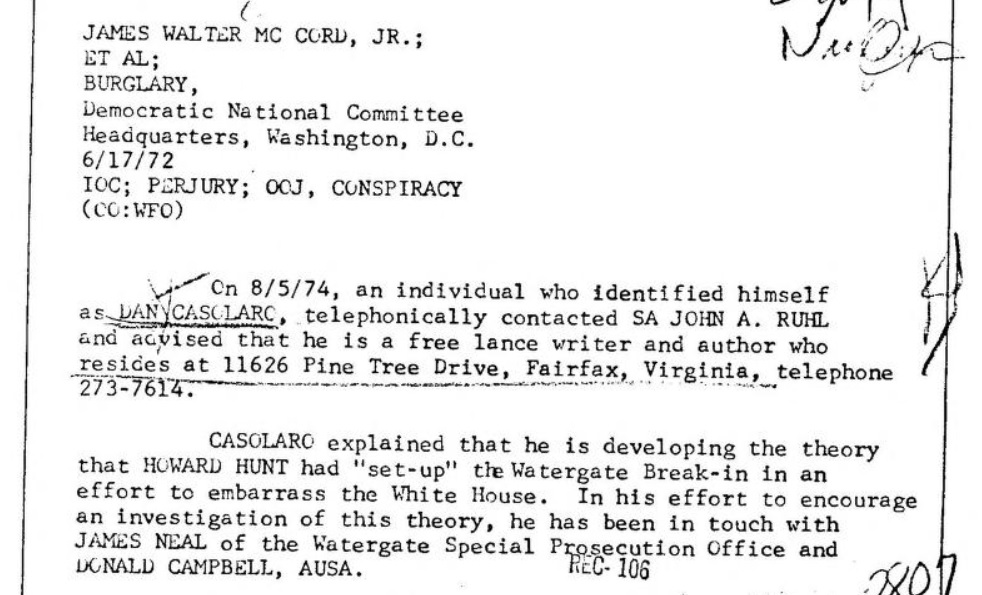
The letters had, before the infamous Watergate break-in, been provided to both the DNC and to Anderson, warning about the Watergate and represent both an important and highly under-investigated and under-reported aspect of the Watergate affair. The letters were known to Congressional investigators who attempted to follow up on the matter, only to have it buried. Much of the testimony, taken in Executive Sessions, remains unavailable and this aspect of the affair was essentially excluded from the final Watergate report and Congressional publications.
In his book, now long out of print, Minority counsel for the Senate Watergate Committee Fred Thompson explained their investigation,
“Had covered many months and many witnesses … We looked into an aspect of Watergate that had not been explored before or since. [We] all came to one conclusion: several people, including some at the Democratic headquarters, had advance knowledge of the Watergate break-in. An obvious effort had been made to conceal facts … but did we have proof 0 proof beyond a reasonable doubt? The answer, reluctantly, was no. Additionally, for our suspicions to amount to anything conclusive we would have to tie this advance knowledge to McCord, or someone else on the inside of the Watergate team, or at least to the plainclothesmen on duty the night of the break-in. We had no such link.”
The missing link, as explained by Thompson, was a way “to tie this advance knowledge to McCord, or someone else on the inside of the Watergate team, or at least to the plainclothesmen on duty the night of the break-in.” Mr. Thompson lamented that they had no such link, but evidence not available to them at the time seems to provide that link in the form of Anderson. That link first suggested itself in the notes of Woodward and Bernstein of the October 9th, 1972 meeting with Deep Throat/X/Mark Felt. (While evidence strongly suggests Deep Throat was a dramatized composite of multiple sources rather than simply Felt, for the moment we will take Woodward and Bernstein’s word for the fact that this meeting was with Mark Felt.)
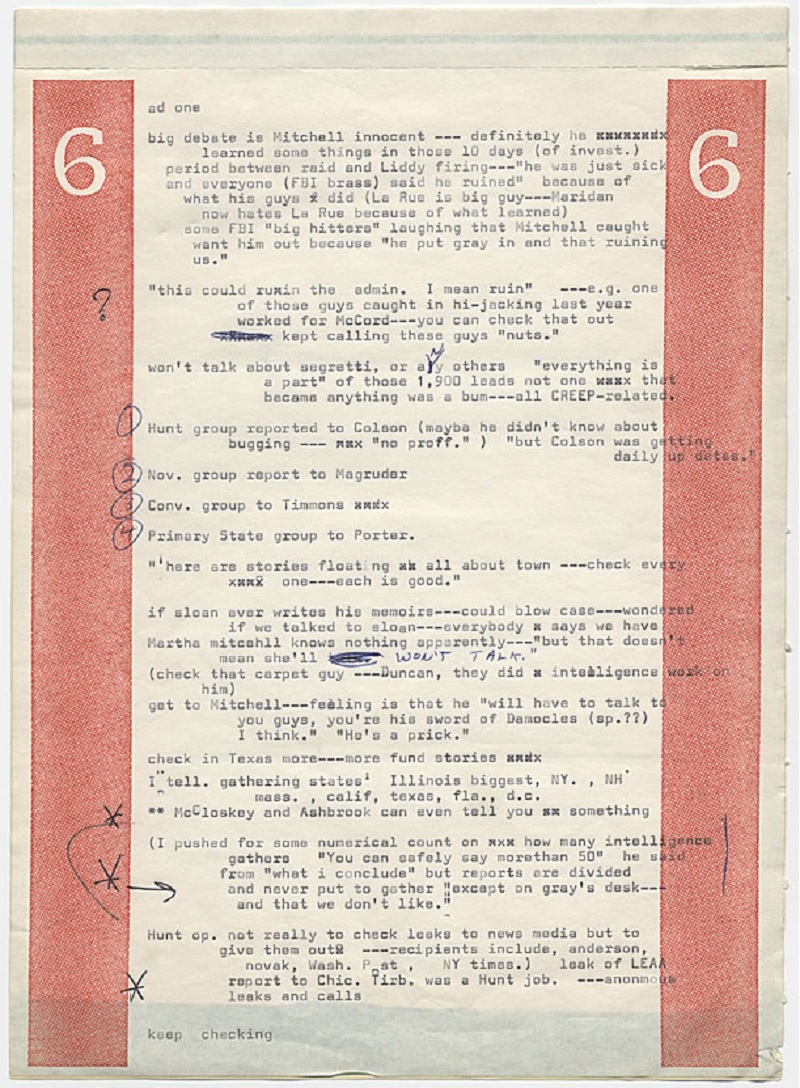
The notes explicitly accuse the Hunt operation, which included CIA employee Bernard Barker and former CIA asset Frank Sturgis, of leaking information to the press, including Anderson. While Hunt may not have set up Watergate to embarrass the White House, it seems that someone or some group did – and one of the most likely candidates was Anderson. To understand the role that he played, it’s necessary to go back and look at Anderson’s friendship with Sturgis, and the letters warning Anderson and the DNC of Watergate type break-in activity.
Anderson, by his own admission, was friends with Sturgis and Barker. In the early ’70s, he described meeting with them in Miami and discussing their recent reconnection with their CIA handler “Eduardo” - a pseudonym for Hunt. Anderson’s connection to Sturgis and Barker would become a subtle and overlooked, albeit recurring, element throughout the Watergate affair – along with Anderson sharing an employer with James McCord. It would also become a damning source of information for Anderson when the letters warning about the Watergate break-in were sent.
Although Casolaro had copies of only the two letters sent to the DNC, there were up to four letters in total, with the other two being sent to Anderson. The letters sent on March 23rd and April 28th were both sent to the DNC, and specifically to Larry O’Brien, whose phone was to be bugged. A third letter was sent to Anderson on April 15th, and a fourth letter sent at an unknown date. Anderson was sent two letters because he “lost” the first one, and ultimately managed to “lose” the second one as well. Anderson’s account of the affair is also completely at odds with the documented facts. It is possible that Anderson may never have lost the letters: included in the Jack Anderson papers donated to the George Washington University is a file relating to William Haddad, who had written the letters. Part of this particular file remains restricted at least until 2032 - making it impossible to review.

According to Anderson’s book, he only received one letter which he dismissed. He then falsely attributes the source of the information to an “ad man” in the November Group (the advertising arm of the Nixon campaign), who had heard it from Watergate burglar McCord and then reported it Haddad who wrote to Anderson. Anderson’s description of this critical series of events matches the Bureau’s description of his recall of another series of events tying him to the Watergate affair, specifically that it was “replete with half-truths, innuendo and insinuation … categorically without basis in fact.”
Unlike many half-truths in Watergate, there is no way to assume that Anderson repeated rumors, made a casual mistake, got confused or simply forgot. His version of events is alarmingly contrary to what has been established by every other witness. According to Anderson, McCord was called down to the November Group to check the phones. This much is true – McCord had been to the November Group at least twice before and again on June 16th, 1972 – mere hours before the fateful Watergate break-in.

This, combined with the fact that G. Gordon Liddy was one of the three founding directors for the group, provides an interesting nexus and provokes some intriguing questions - but none of it supports Anderson’s version of events that McCord told them that they were bugging the Watergate, information which then leaked to Haddad.
There is no question as to who was the source for Haddad, the man who wrote to O’Brien at the DNC and to Anderson. Haddad’s source was known to Anderson at the time, and was publicly identified before Anderson published his book: Arthur James (A.J.) Woolston-Smith, an expatriate New Zealander who had worked in the U.S. as a private investigator for some time, including for Robert A. Maheu Associates during the ’60s. He reportedly worked with CIA, and his office in New York was regularly used to help resettle Cuban veterans of the Bay of Pigs. Around December, 1971 he began to tell Haddad that the November Group was “up to no good.” (A statement that would be echoed, according to Len Colodny’s Silent Coup, by Deep Throat.) On March 23rd, Haddad wrote the first letter to O’Brien, warning of “sophisticated surveillance techniques” that were being employed against the Democrats.
The next week, O’Brien had John Stewart look into the matter and speak with Haddad. Haddad and Woolston-Smith reportedly stayed in touch with the Democrats, and Haddad followed up again with another letter on April 28th (13 days after he contacted Anderson).
I talked to Woolston-Smith. Yes, he does have good information; and, yes, he did want to cover expenses for producing it in an acceptable way. He explains that he wasn’t looking for payment for his services, but to cover what looked like necessary expenses to tie down his theory with factual presentations (like checks, etc.).
Instead of pursuing this with money, I decided to see what a good investigative reporting operation could do with it now. So I went ahead along those lines. If they draw a blank, I’ll be back to you on how to proceed, and I’ll keep you informed.
My own journalistic judgment is that the story is true and explosive. It would be nice for a third party to uncover it, but if they fail due to the type of inside work required, I would move back to Woolston-Smith.
The information provided by Woolston-Smith was consistently up-to-date and almost entirely accurate, often seeming to come mere days after the Watergate burglars themselves became aware of the next stage of their activities, and at times while those activities were still being planned. The given reasons behind those activities were the same false explanations that were given to Sturgis, Barker and others working under Hunt – namely that they were looking for proof that the Democrats were being funded by Cuba. While Woolston-Smith’s source remains unknown, most agree that he was the sole source for information about the planned break-in, including that it would involve Liddy and McCord. According to Woolston-Smith, however, there was another source for one piece of information - the information about the anti-Castro Cubans’ planned involvement in the Watergate burglary came from Anderson. This also contradicts the implausible statement from Anderson that he was unable to uncover anything despite being given detailed information and being friends with those involved.
Like Anderson, O’Brien would lie about the event years later, as he had under questioning, omitting many details and fabricating others. In an interview published in the LBJ Library Oral History Collection, O’Brien said:

Many have wondered at one time or another if there was a Democratic trap set for the Watergate burglars, although that theory has often been dismissed. Until now, many have pointed to Jim Hougan’s Secret Agenda, rightly considered one of the authoritative texts on Watergate, and his rejection of the theory that the Democrats set a trap. Almost exactly one year ago - December 7th, 2016 - Hougan confirmed to the author that his understanding of the Watergate affair has evolved since he first wrote the book, and that he no longer holds those objections to the theory that the Democrats set a trap for the Watergate burglars.
Understanding that trap, and Jack Anderson’s role in it, requires more information. Among these are several significant points, which are explored below:
- Anderson met with Sturgis and the other Watergate burglars hours before the burglary.
- Anderson tried to bail Sturgis out of jail after his arrest.
- Anderson’s articles used information that could only have come from material stolen by the Watergate burglars.
- Multiple witnesses implicate Anderson as playing a role in planning other Watergate activities.
Anderson’s account of his meeting Sturgis and the others hours at the same time McCord was at the November Group, hours before the fateful Watergate break-in, is alarmingly contradicted by every other source of information. According to Anderson, he ran into them while he was on his way to a speaking engagement with the Cleveland Press. The Cleveland Press denied this, saying they had never had him as a speaker and had no record of him giving any speeches or making any appearances in Cleveland at that time.
Like Anderson’s, O’Brien’s statement (excerpted above) on the matter are so at odds with the record recounted by others that they are impossible to accept as having been offered in good faith. Stewart met with Haddad and others, including Ben Winter- a disinterested party who merely sat in on the meeting. When he testified, Winter made it clear that the information seemed quite firm and that Stewart seemed to be taking it seriously. Winter’s version of events seems to corroborate Haddad’s and Woolston-Smith’s, while further discrediting Anderson.
Anderson’s presumption of innocence is further tarnished by additional guilty knowledge. In late June, 1972 Democratic officials identified information in one of Anderson’s column that, according to Woodward, could only have come from one of the files in Democratic Headquarters - a file which was stolen. Anderson denied this and said it was merely being made to discredit him. Anderson’s claim to not use, or need, “stolen” information is also contradicted by his own record which included lying, cheating, stealing, and bribing. In his own words, Anderson acknowledged that deceit was simply part of what he does.
Deceit is a constant companion in the quest for secret information about high officials, whether that questing is done by intelligence operatives to inform governments or by newspapermen to inform the public.
If Anderson was receiving these materials from Hunt via Sturgis and Barker (or any of the conspirators), then he would undoubtedly have fully understood the implications of Haddad’s letter talking about the plan to break-in of the DNC.
If Anderson and O’Brien hadn’t repeatedly lied about the forewarning of Watergate and the circumstances around it, it would be easier to accept their denials of setting a trap. Unfortunately for Anderson, several witnesses accuse him of doing just that. Independently, the two accounts would be easy to dismiss. Together, they present a strong argument compared to Anderson’s provable lies, his use of material stolen from the Watergate and the FBI’s own dismissal of Anderson’s statements as completely untrue.
One statement came from Kaiser. The FBI was quick to dismiss his statement due to his troubled past, although it would be corroborated by another individual. According to Kaiser, he had spent a considerable amount of time with Sturgis in 1972 due to their longstanding friendship. It was during this time that Sturgis asked him if he would be interested in helping instigate a riot at the Republican National Convention as part of a plan to make anti-war protesters look bad.

Ultimately, Kaiser decided not to cooperate with the FBI (who did not appear to take him seriously) and he reached out to the Watergate Committee, while identifying one of the backers of the operation as Sturgis’ friend - Anderson.
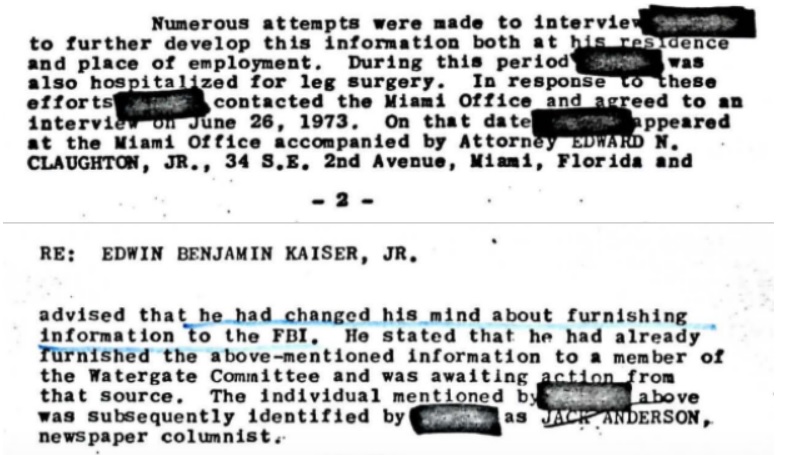
Senate investigators met with Kaiser over the Watergate affair, and received a more detailed version of the information he had provided to the FBI.


This claim would be too incredible to consider if not for the corroboration from another private investigator who had worked with Hunt and who was also friends with Sturgis and Barker. According to an FBI memo, Vincent J. Hannard, identified by Agee’s CounterSpy Magazine as a CIA operative, reporting having been contacted by both Sturgis and Barker over instigating a riot at the Republican National Convention with the intention of undermining the Vietnam Veterans Against the War.
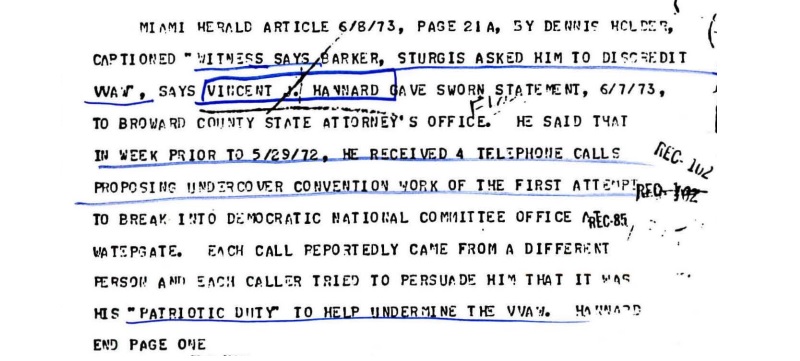
The FBI file tried to discredit Hannard by claiming that he was unable to differentiate between truth and lies, but also noted that he was an informant for both local and federal law enforcement and was a key witness in several cases.

While it might be easy to discount Hannard’s statement, despite the FBI considering him to be reliable enough to act as an informant and a key witness, his statements should be considered in light of the FBI’s determination that Anderson was lying about the matter.
Several months later, Anderson seems to have sprung one of the traps he had allegedly helped set with the Watergate burglars by “supporting” their efforts to undermine VVAW through a riot at the RNC. Anderson printed a column in which he tied the affair to the Watergate burglars, and in which he accused the entire affair of being a setup to entrap the VVAW. The FBI responded by pointing to “obvious contradictions” in Anderson’s account, and accusing it of being full of “half-truths, innuendo and insinuation … categorically without basis in fact.”


When it comes to setting a trap at the Watergate, Anderson consistently told lies (both big and small) to investigators, Congress and the public about what happened. Multiple witnesses have tied him to the affair in several ways, all consistent with the techniques he’s known to have employed over the years. Democrats and Republicans alike have pointed the finger at him, Deep Throat tied him to the Watergate leaks and it seems undeniable that if there was a Democratic setup for the Watergate burglars, Anderson either helped create it or knew about it and exploited it.
At this point, Anderson’s involvement in creating Watergate is a matter of degree - not a question of if.
Read the FBI memo on Casolaro’s warning embedded below.
Like Emma Best’s work? Support her on Patreon.
Image via Wikimedia Commons
